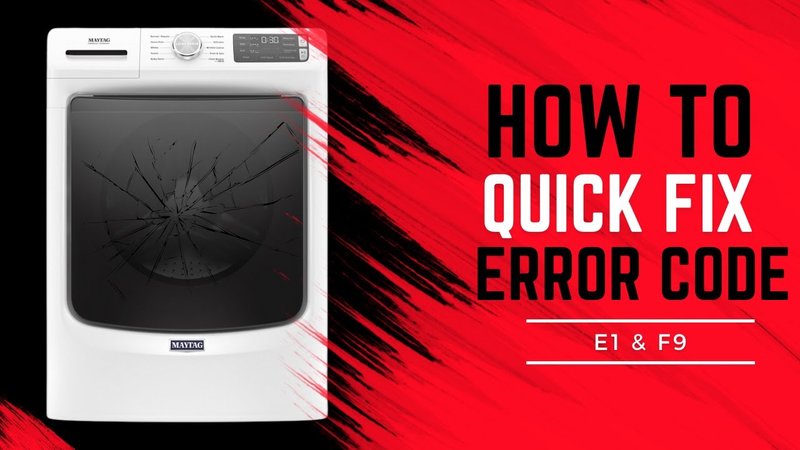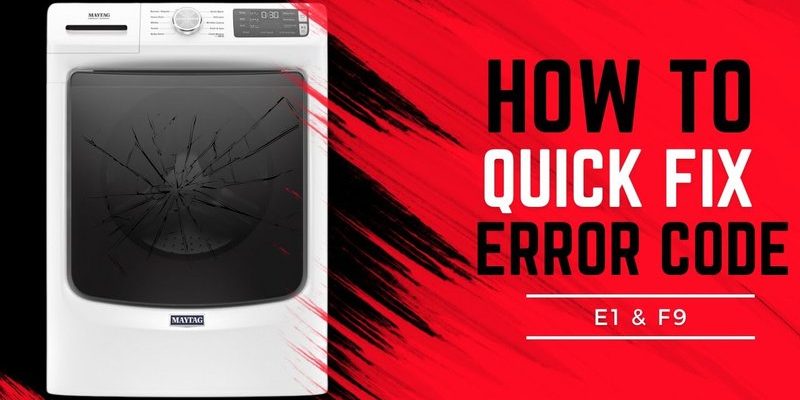
The Error Code E1 is essentially your washing machine’s distress signal, indicating that it’s having trouble managing its water supply. It’s a bit like you trying to take a shower with a blocked showerhead — frustrating, right? Water isn’t flowing as it should, and the washing machine is struggling to do its job without a hitch. But here’s the good news: by understanding this issue better, you can take steps to prevent it from happening again and keep your appliance humming along smoothly. Let’s dive in and see how you can ensure your Maytag stays trouble-free!
Understanding Error Code E1: What’s Really Happening?
Before we delve into preventing this issue, it’s crucial to understand *what’s actually going on* when Error Code E1 pops up. This code is your washing machine’s way of letting you know there is a problem with water intake. Imagine trying to fill a swimming pool with a trickling hose — it’s inefficient and takes forever. Similarly, if your washing machine isn’t getting enough water at the right pressure, it can’t perform its wash cycles correctly.
So, what causes this water intake issue? A common culprit is a blocked or kinked inlet hose. Think of it as bending a drinking straw — the water (or in this case, detergent-laden water) can’t flow properly. Additionally, low water pressure from your home’s plumbing can also trigger this error. It’s like trying to drink a thick milkshake through that same straw — it’s just not going to work well if there’s not enough suction.
Finally, a malfunctioning water inlet valve could be the source of the problem. This valve is essentially the gatekeeper for water entering your machine. If it’s not opening as it should, your washing machine won’t receive the water it needs. It’s the appliance equivalent of a faucet that won’t turn on all the way. Understanding these causes is the first step toward preventing them in the future.
Regular Maintenance: Your First Line of Defense
You’ve probably heard it before: prevention is better than cure. Well, it’s true for washing machines too. Regular maintenance is like giving your appliance a health check-up, ensuring everything is running as it should. Start by inspecting the water inlet hoses. Make sure they’re not crimped or kinked, and that the connections are tight. It’s like ensuring the garden hose isn’t twisted so the water flows freely.
Next, check for any visible leaks or damages. If you spot any, it’s time to replace those hoses. Think of them as the lifeblood of your washing machine — if they’re compromised, so is your appliance’s ability to function effectively. Additionally, ensure there’s adequate water pressure from your home’s plumbing. Sometimes, municipal water pressure issues can affect your appliance, so it’s worth keeping an eye on.
Lastly, inspect and clean the water inlet valve filter. Over time, minerals and debris can build up here, causing water flow problems akin to a clogged filter in your HVAC system. By regularly cleaning this filter, you’re giving your washing machine a much-needed breath of fresh air, allowing it to function smoothly.
Troubleshooting Common Water Supply Issues
Sometimes, despite your best efforts, issues still arise. Here’s where troubleshooting comes in handy. Start by checking for obvious obstructions in the water supply lines. Imagine trying to drink a smoothie through a blocked straw — a simple check can save a lot of headaches. Ensure the taps supplying the washing machine are fully open. It’s an easy fix that’s often overlooked, but it can make all the difference.
If your water pressure seems low, consider calling a professional to assess the plumbing situation. It could be as simple as a sediment buildup in your pipes, similar to plaque in arteries that restricts blood flow. Resolving this can restore the pressure your washing machine needs to function properly.
In cases where the water inlet valve might be the issue, it’s wise to consult with a technician. This component’s repair or replacement is akin to getting a new battery for your car — you need the right one for things to function correctly. Attempting to repair it without proper knowledge might cause more harm than good.
Future-Proofing Your Washing Machine
Once you’ve tackled the immediate issues and understood their causes, it’s time to think long-term. Future-proofing your washing machine involves creating a proactive maintenance schedule. This isn’t just about fixing problems as they arise but preventing them from happening in the first place. Set reminders to check the hoses and the water inlet valve every few months. It’s like regular oil changes for a car; small actions can prevent bigger troubles down the line.
Consider water softeners if you live in an area with hard water. Think of hard water as a sneaky villain that builds up in your machine, causing inefficiencies over time. A water softener can act like a personal superhero, neutralizing these effects and extending the life of your machine.
Finally, it never hurts to have a professional inspection annually. Think of this as a doctor’s check-up for your appliance. A trained eye can spot potential issues before they become major headaches, ensuring your washing machine stays in top-notch condition for years to come.
By following these steps and maintaining good practices, you can effectively prevent Maytag Washing Machines Error Code E1 in the future, keeping your beloved appliance running without a hitch.
